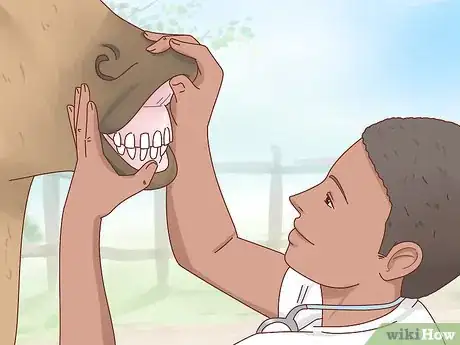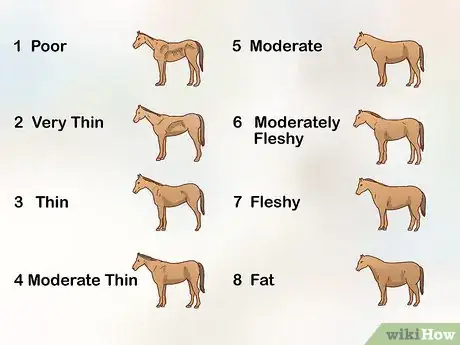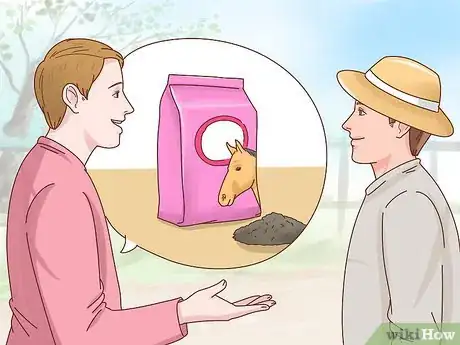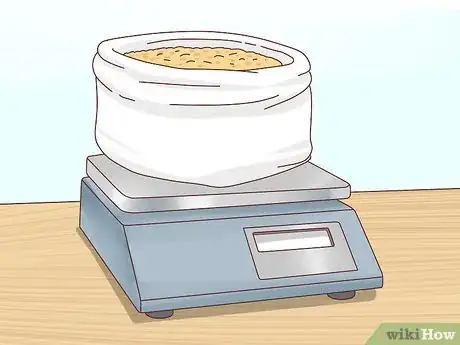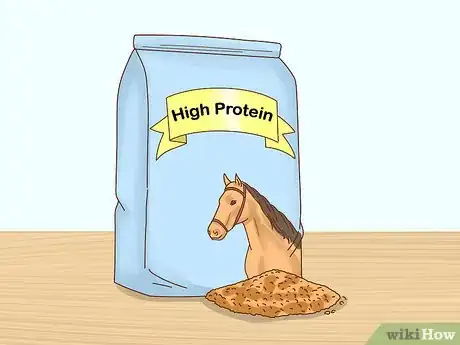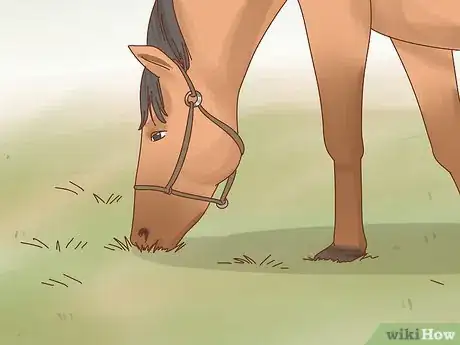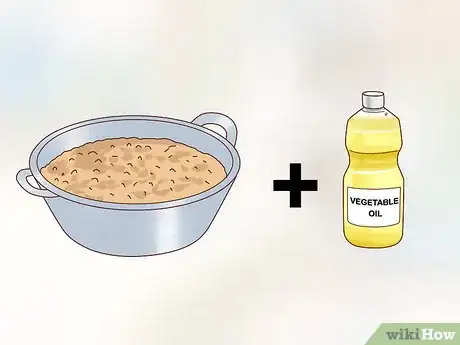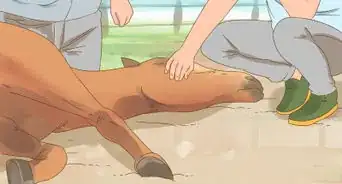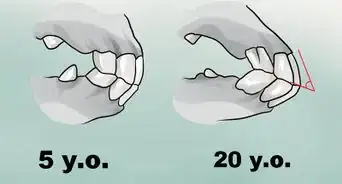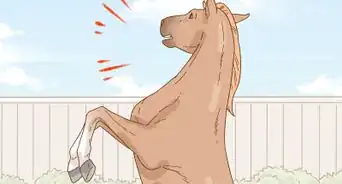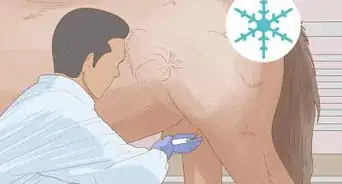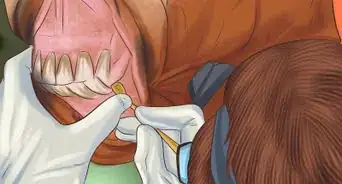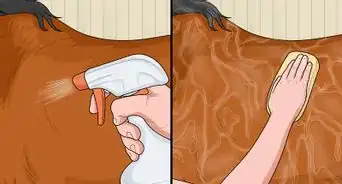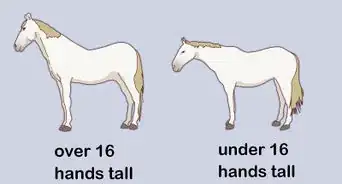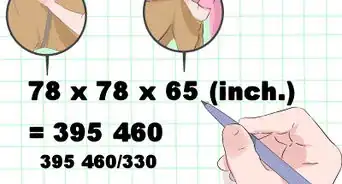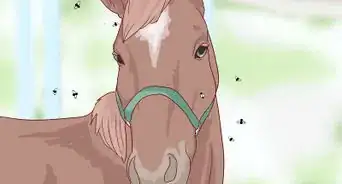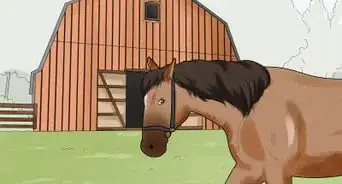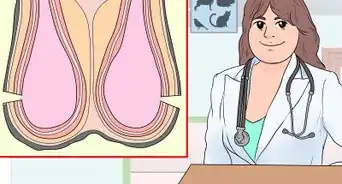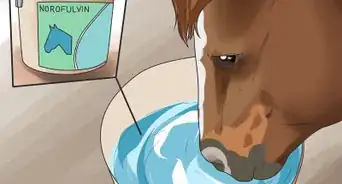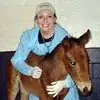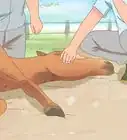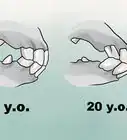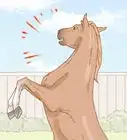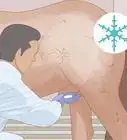This article was co-authored by Ryan Corrigan, LVT, VTS-EVN. Ryan Corrigan is a Licensed Veterinary Technician in California. She received her Bachelor of Science in Veterinary Technology from Purdue University in 2010. She is also a Member of the Academy of Equine Veterinary Nursing Technicians since 2011.
There are 12 references cited in this article, which can be found at the bottom of the page.
This article has been viewed 130,613 times.
Fattening a horse, also called conditioning, is a long process, but one that can improve your horse's health. Your horse may be underweight for a variety of reasons, like wintering in harsh conditions, not getting enough calories, or feeding on poor pasture. If you can easily see your horse's ribs sticking out through a dull coat, it may have "ill-thrift" meaning that it lacks energy and can't be worked or ridden. Before you simply start feeding your horse more feed, check for any health issues that could be preventing weight gain. Once you've ensured that your horse is healthy, there are several things you can do to fatten up your horse.
Steps
Ensuring the Horse is Healthy
-
1Check your horse for health issues. Before you begin fattening up your horse, make sure there are no other health problems that could be causing weight loss. You'll need to take your horse to the veterinarian to ensure your horse is healthy. If your horse has a medical condition, the veterinarian will be able to prescribe the correct treatment, which will most likely help your horse regain any lost weight.[1]
- The two major causes of weight loss in horses are internal parasites (worms) and poor dental conditions.
-
2Pay attention to your horse's mouth. You may notice that your horse is shy when you try to put the bit in his mouth. Or, it might be a messy eater, dropping partially chewed lumps of food on the ground and in its water bowl (a process known as "quidding"). Your horse may do these because it has tooth problems. But, if your horse is feeling pain when it chews, it may cut back on eating rather than deal with the pain, so there won't be other symptoms.[2]
- As horses age, they can develop points (sharp edges), hooks (a jagged tooth that doesn't make contact with the lower or upper teeth), and waves (unevenly worn down molars) in both the upper and lower teeth (arcades). These can prevent them from chewing their food properly, resulting in a loss of nutrients.
Advertisement -
3Have the veterinarian check your horse's teeth. Get your veterinarian to look at your horse's teeth to determine if the weight loss may be caused by tooth problems. Your vet may be able to tell if the horse isn't able to sufficiently break down its feed.
- A horse's teeth continue to grow until the mid-twenties, so it's a good idea to have them examined and floated (rasped down) every year, if they need it.[3]
-
4Check your horse for worms. Your veterinarian should run a complete egg count on a sample of your horse's feces to identify specific species of parasites (worms). If your horse has a large population of strongyles (Cyathostomiasis), it's probably experiencing gut inflammation or stomach ache, and is unable to completely digest its food. Once the species of worms has been identified, your horse will be de-wormed 2 separate times, about 3 weeks apart. This gets rid of adult worms, as well as the developing eggs and larvae.[4]
- Horses are more likely to have worms if they have grazed on pasture that has been heavily grazed by other horses and that are heavily contaminated with horse feces which harbor the worm eggs.
- Strongyles account for around 95% of worm eggs in pasture, so infection is highly likely under the right circumstances. Other species that are found in pastures, like roundworms, can also cause weight loss.
-
5Get a complete blood test. While you may not want the expense, the test will show if your horse is deficient in any essential minerals and if all of the internal organs are functioning properly. This information can help you determine if the horse needs supplements. The veterinarian will also examine your horse for other problems which could interfere with its ability to eat, such as respiratory disease, chronic diarrhea, gastric ulcers, or behavioral problems.[5]
- Some behavioral problems can interfere with eating, such as wind sucking or crib biting. With these, the horse sucks in a lot of air when chewing, which can cause stomach bloating. This makes your horse feel full, when it's actually just full of air.[6]
Feeding Your Horse
-
1Condition score your horse. Horses are scored on a scale of 1 to 9 according to their amount of muscle and fat. This is figured by looking at, feeling, and ranking 6 areas of the horse's body.[7] The veterinarian can help you determine your horse's score which will let you decide if your horse needs to gain weight. The ideal body score is a 5 or 6.[8]
- Scores of 1 to 4 are considered thin, and will need more feed to boost weight.
- An extremely underweight horse will need a feed that is high in protein and fats (such as rice bran) to promote weight gain.
- Keep in mind that a score of 9 would mean that a horse is very obese and this is also unhealthy.
-
2Get advice on choosing a feed. Talk with your local feed merchant. The merchant will know the benefits of the various feeds that are stocked. Describe your horse's condition, so you can get a good recommendation on what feed you should be purchasing. Just remember not to feed a lot of grain, since this can be hard for your horse to digest.[9]
- You can also ask the advice of fellow equestrians. Many of them may be able to offer helpful tips and tricks to build up your horse's condition.
-
3Determine how much food your horse needs. If your horse is thin, ask your vet to recommend a target weight. You'll then want to look at the feed package and weigh out how much it should be eating a day. Don't use a scoop, since this can be inaccurate and you may be overestimating how much you're feeding your horse.[10] Be sure to feed for your horse's desired weight and allow it access to a pasture.
- An average horse will need 1.8 to 2% of its body weight in feed (including supplements). So, an average horse in good condition needs about 18 to 20 pounds of feed a day.[11]
- If you're trying to fatten your horse, consider upping the amount of food by 2.3 to 2.5% of body weight for a slow gradual gain.
-
4Consider using a high-protein hard feed. If your horse is severely underweight, consider feeding it a high-protein hard feed, which is calorie dense. You can give a high energy extruded (shaped) food (500-700g for every 100 kg of body weight) mixed with an equal volume of chaff (straw cut up for fodder or seed husks). Or, you could feed rolled barley and dampened rice bran in the same quantities.
- Avoid suddenly increasing the quantity of food, which could cause your horse to gorge and develop diarrhea or even colic. Decide on the amount of feed for the horse's target weight and divide it into 3 to 4 feeds spaced over the day.[12]
-
5Ensure your horse has sufficient grass. Grass is the staple food of the horse's diet. Without it, your horse may not be eating enough bulk (roughage), causing it to be thin. Make sure your horse gets at least 3 to 4 hours on grass, but don't just turn it out and let it graze all day. Not only will your horse strip the pasture down to the ground, but it will overload its gut and it could develop laminitis, diarrhea, or colic as a result.[13]
- Consider giving the horse good quality hay before you turn it out into the pasture, which can keep it from eating too much fresh grass. Hay can also regulate the bowels and provide slow release energy for your horse.
- Limit pasturing on lush spring grass to 2 hours (1 in the morning and 1 in the afternoon). This grass is rich in carbohydrates, which greatly increases the risk of laminitis or diarrhea.[14]
-
6Consider adding oils to the feed. Start by adding just a 1/4 cup of oil to your horse's feed per day, adding another 1/4 cup within a few days. Build up to about 2 cups of oil a day. You can use corn, peanut, canola, or vegetable oil.[15] Adding oils to your horse's feed will help increase his weight and can aid in digestion.
- While your horse is on a higher calorie diet, make sure it's getting a little light exercise. This way, your horse will start to condition and build muscle.[16]
Expert Q&A
Did you know you can get expert answers for this article?
Unlock expert answers by supporting wikiHow
-
QuestionCan I use foal milk replacer for a skinny adult horse?
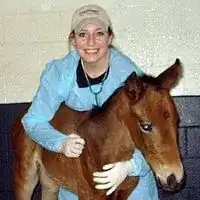 Ryan Corrigan, LVT, VTS-EVNRyan Corrigan is a Licensed Veterinary Technician in California. She received her Bachelor of Science in Veterinary Technology from Purdue University in 2010. She is also a Member of the Academy of Equine Veterinary Nursing Technicians since 2011.
Ryan Corrigan, LVT, VTS-EVNRyan Corrigan is a Licensed Veterinary Technician in California. She received her Bachelor of Science in Veterinary Technology from Purdue University in 2010. She is also a Member of the Academy of Equine Veterinary Nursing Technicians since 2011.
Licensed Veterinary Technician
Warnings
- Do not feed any supplements that your horse does not need. Additives such as selenium and sulfur are poisonous in large doses. Do not feed any of these without knowing the exact dosage your horse requires.⧼thumbs_response⧽
References
- ↑ http://www.equisearch.com/article/equine-emergency-when-to-call-the-vet-17541
- ↑ Quidding: Katherine Blocksdorf. At Home
- ↑ http://www.csjequine.com/Frequently-Asked-Questions.html
- ↑ Fattening Up a Thin Horse. Dr. John Kohnke. BVSc, RDA
- ↑ http://newscenter.equinesite.com/equinehealth/216-causes-of-chronic-weight-loss.html
- ↑ https://www.aspca.org/pet-care/virtual-pet-behaviorist/horse-behavior/cribbing
- ↑ http://www.thehorse.com/articles/33885/body-condition-scoring-hands-on-help-for-your-horse
- ↑ http://umaine.edu/publications/1010e/
- ↑ http://equusmagazine.com/article/feeding-weight-gain-25995
- ↑ http://holistichorse.com/health-care/scoops-measure-volume,-not-weight/
- ↑ http://www.nacmo.org/horse_health.php
- ↑ Fattening Up a Thin Horse. Dr. John Kohnke. BVSc, RDA
- ↑ Fattening Up a Thin Horse. Dr. John Kohnke. BVSc, RDA
- ↑ Fattening Up a Thin Horse. Dr. John Kohnke. BVSc, RDA
- ↑ http://equusmagazine.com/article/feeding-weight-gain-25995
- ↑ Fattening Up a Thin Horse. Dr. John Kohnke. BVSc, RDA
- ↑ A Complete Guide to the Types of Worms Affecting Horses. Medical Animal
About This Article
To fatten up a horse, start by having a veterinarian examine your horse to make sure that it's healthy. If your horse is healthy but too thin, determine how much food your horse needs by asking your vet to recommend a target weight. Then, use this figure to calculate how much feed you supply. While an average horse will need 1.8 - 2% of body weight in feed, a thinner horse may need 2.3 - 2.5% of its body weight. Additionally, use a high-protein, calorie-dense hard feed, and allow your horse to graze on grass for at least 3-4 hours per day. For more tips from our Veterinary reviewer, including how to add oils to your horse feed to increase weight and aid digestion, keep reading!


